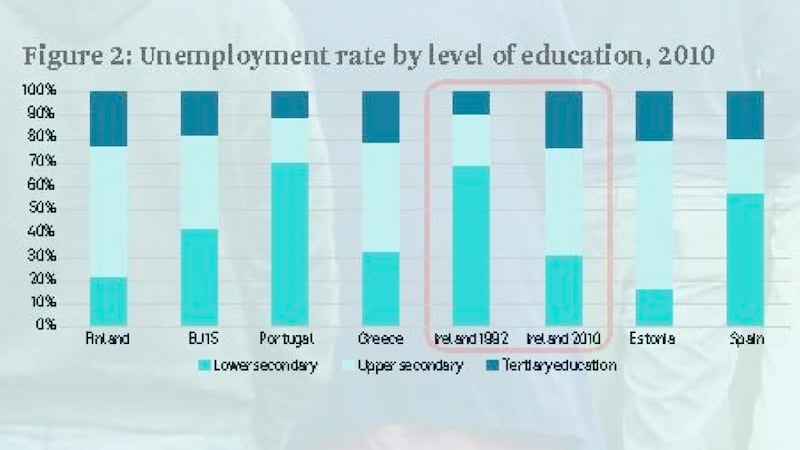In the years following the financial and economic collapse of 2008, the human misery caused was reflected most clearly in the rapidly rising numbers unemployed and the related emigration figures.
Many observers believed it would take a very long time for the economy to recover and that it could be a generation before we might return to full employment. That fear was shared by the troika.
This pessimism about the labour market reflected a belief that the rise and fall of unemployment experiences a ratchet effect – unemployment can go up quickly, but getting it down again is a slow process. The expectation was that many of those who lost their jobs would find their skills gradually eroding and would become progressively more detached from the job market, with the result that they could be left behind when the jobs market picked up again. The expectation was we would be left with a legacy of long-term unemployment when growth resumed.

Happily, the reality has turned out to be rather more favourable.
The long-term unemployment rate did rise rapidly in the early years following the collapse, peaking in 2012 at 9 per cent of the labour force. This was the same peak it had reached at the end of the previous economic crisis in 1994 (Figure 1).
The experience in the early Celtic Tiger years of 1994 to 1997 was that the rate of long-term unemployment fell slowly– by only one percentage point a year – in spite of truly exceptional growth. As a result of this past experience, many observers believed that in the current more modest recovery, unemployment would fall even more slowly.
Rapid decline
However, this time around things are different. Long-term unemployment, as shown in Figure 1, has declined at 1.5 percentage points a year since 2013, more rapidly than in the mid-1990s. And this decline shows no signs of slowing. In data published for last month, the fall in long-term unemployment has been even more rapid than among those out of work for under a year.
There is now a reasonably clear explanation as to why the labour market performance of the economy is better this time round than in the 1990s. As shown in Figure 2, those who lost their jobs in the recent crisis and found themselves unemployed had a very different level of educational attainment than the long-term unemployed of 1992.
Whereas in the early 1990s, the vast majority of those unemployed had not completed their Leaving Certificate, this time around 70 per cent of the unemployed had at least completed their Leaving Certificate and many had third-level qualifications. This has meant that they are much more employable in the recovering economy.
As shown in Figure 2, when we compare the educational composition of unemployed people in Ireland with a range of other EU countries, Ireland’s unemployed have markedly higher levels of education than those of Spain or Portugal. The educational composition of the Iberian economies is closer to the Ireland of the 1990s than the Ireland of today.
As a result, in a world where demand for skilled labour is rising more rapidly than for unskilled, recovery in the labour market in Spain and Portugal may be rather slower than in Ireland.
The economic turnaround still has some way to go in Ireland. In particular, output in construction is still well below what is required to build the new homes and offices we need. This should lead to increased demand for building workers and others with skills that can be deployed in that area.
In turn that should further reduce the numbers out of work, as well as attracting home some of the building workers who emigrated during the recession.
Economically inactive
The labour force is defined as those at work and those unemployed and actively looking for work. Some of those who lost their jobs in the recession are recorded as “economically inactive” rather than unemployed. This economically inactive group includes people who would be interested in a suitable job if it came up, although not formally recorded as part of the labour force.
CSO figures suggest the “inactive but interested in work” group is falling rapidly, suggesting many in this group have found work. This will help reverse the fall in labour market participation rates experienced in the economic crisis.
It is likely there remains a pool of people, including some with good qualifications, who are not currently in the labour force. Improved take-home pay, as wages begin to rise and taxes on earnings fall, alongside the pull of increased growth are likely to see more of this group rejoining the workforce and getting jobs.
Any dynamic economy will have some limited level of unemployment, as old firms and industries die and new ones take their place, and as people move between jobs. In Ireland, full employment may be taken to be consistent with an unemployment rate of about 5 per cent. Such a level unemployment is now achievable within three years, something that looked impossible at the height of the crisis.
This also means that, as in the 1990s recovery, we are likely see the current pattern of emigration reversing. Many of the emigrants of the crisis years will prove to be homing pigeons, returning to work in Ireland. Past experience also suggests that the economy and society as a whole will be the richer from such a reversal in migration flows, as those returning bring with them new skills and wider experience.








